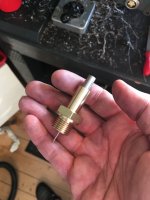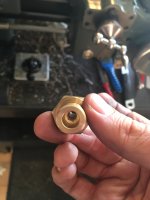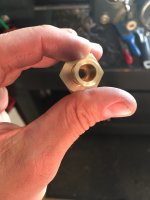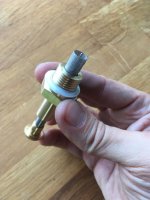basiecally
Well-known member
Hej!
Har lyckats åstadkomma en nålventil för flödeskontroll till min Isomac mondiale. Hade ingen förlaga att jämföra med så jag fick gå på vad som känns rimligt.
Den nya ”svamptoppen” är svarvad i mässing och själva nålen är rostfritt. Valde en M6gänga för justeringen, den ger 1mm/varv och det blev rimligt med en kona på 2 grader på nålen. Har även tillverkat en gicleur med ett hål på 2mm som ska matcha. Med nålen längst urskruvad motsvarar det en öppning på strax över den 0,8mm diameter öppning som fanns där i original. Helt inskruvas stänger den av helt, om mina beräkningar stämmer.
Nästa steg blir att beställa gruppmanometer och tillverka ett trevligt handtag till den!




Har lyckats åstadkomma en nålventil för flödeskontroll till min Isomac mondiale. Hade ingen förlaga att jämföra med så jag fick gå på vad som känns rimligt.
Den nya ”svamptoppen” är svarvad i mässing och själva nålen är rostfritt. Valde en M6gänga för justeringen, den ger 1mm/varv och det blev rimligt med en kona på 2 grader på nålen. Har även tillverkat en gicleur med ett hål på 2mm som ska matcha. Med nålen längst urskruvad motsvarar det en öppning på strax över den 0,8mm diameter öppning som fanns där i original. Helt inskruvas stänger den av helt, om mina beräkningar stämmer.
Nästa steg blir att beställa gruppmanometer och tillverka ett trevligt handtag till den!









